Costa Rica really blows!
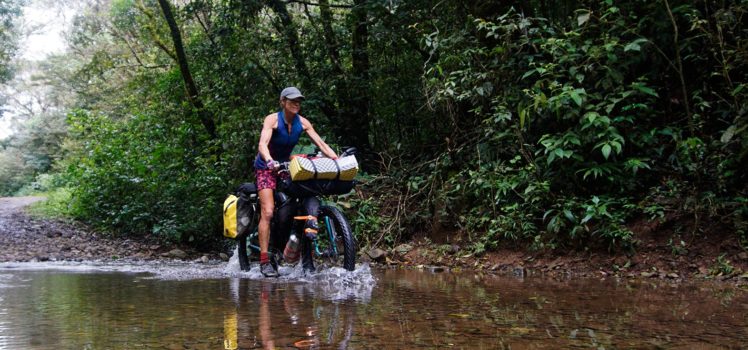
Thirty-five kilometers. That’s all that separated Rivas, our final Nicaraguan stopping point, from the border of Costa Rica. Because we had returned to the mainland from Ometepe Island the day before, removing any uncertainty involved with a ferry transit, we were pretty confident that we could bang off that distance easily and make our way to our first Costa Rican campsite, a secluded little spot that our friends had previously scoped out.
When we set off riding, pre-breakfast and even pre-coffee, we did so under overcast skies. The road we were traveling on was the famed or rather infamous Pan Am Highway. This section was much less busy than others though, and relatively scenic, paralleling the coastline of Lake Nicaragua.

Unless you get right up beside them, it’s difficult to judge just how large the wind turbines are.

They do not build wind farms where it is only occasionally windy!
The dominant feature of the ride was the large wind farm that lined the western coast of the lake. We were able to see the wind turbines from a distance when we traveled to Ometepe Island by ferry but here we were seeing them up close and in action. In point of fact, this was the closest that we had ever ridden to the giant structures and with the strong wind that was blowing, they were working overtime and generating a significant amount of noise in the process. We were both just happy that the wind was on our sides — a beam reach for the sailors still reading our blog — instead of in our faces.
The border crossing into Costa Rica was relatively painless. Without intending to do so, we acquired the services of a “helper” named José who lead us through the multi-step Nicaraguan exit. For his services, we tipped him $2.00 US. He was happy with that and given the time saving for us, not having to wander around, wondering where to go next, I’d say that it was money well spent.
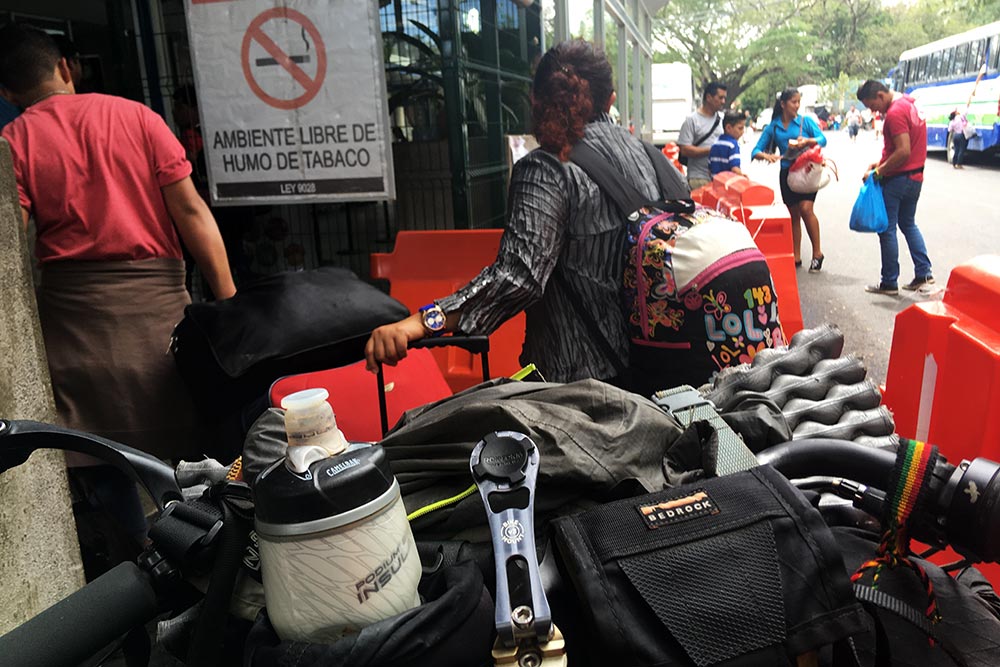
Walking our bikes through crowded immigration offices is always fun.

There were extremely long lines of trucks on both sides of the border.
When we cleared into Costa Rica we were asked our destination. I’ve learned to say that our destination is Argentina and that we were simply transiting through Costa Rica. That seemed to satisfy the officer and we were given 90 days to complete our transit, much more time than we expect to remain here.
Once the formalities were completed, we got back on the highway and made our way to La Cruz, one of the closest cities to the border and where we had planned to leave the highway. The ride there was uneventful but having missed our morning meal, the only thing on our minds upon arrival was to find an inexpensive place to eat.
It’s worth pointing out that Costa Rica has a reputation amongst cycle tourers. That being that it is expensive. Costa Rica is a beautiful country and because of this, it has developed a strong tourist industry. Unfortunately for us, along with that comes tourist prices.
While we slowly pedaled up the road, scanning the storefronts for a place to eat, we were surprised to have another cyclist ride up behind us. Luis, who we learned hails from Ushuaia, our goal destination, told us that he is riding north to Mexico. Unfortunately, he explained, he was turned away from the Nicaraguan border the day before for not having an immunization card for Yellow Fever. He had ridden back to La Cruz hoping to acquire it and having done so, was just about to return to the border to make a second attempt. I hope he made it!
Most people reading this will likely find it hard to believe just how chilly it was in La Cruz. The sky was overcast, it was still extremely windy, and it had even started to sprinkle a bit. The wind especially was making us doubt our plans to camp on the beach but the pricey hotels (we only checked one just to see) made our resolve stronger. After a quick visit to the grocery store and the ATM, we were off, flying downhill to the coast.

We were heading to a beach way down there.
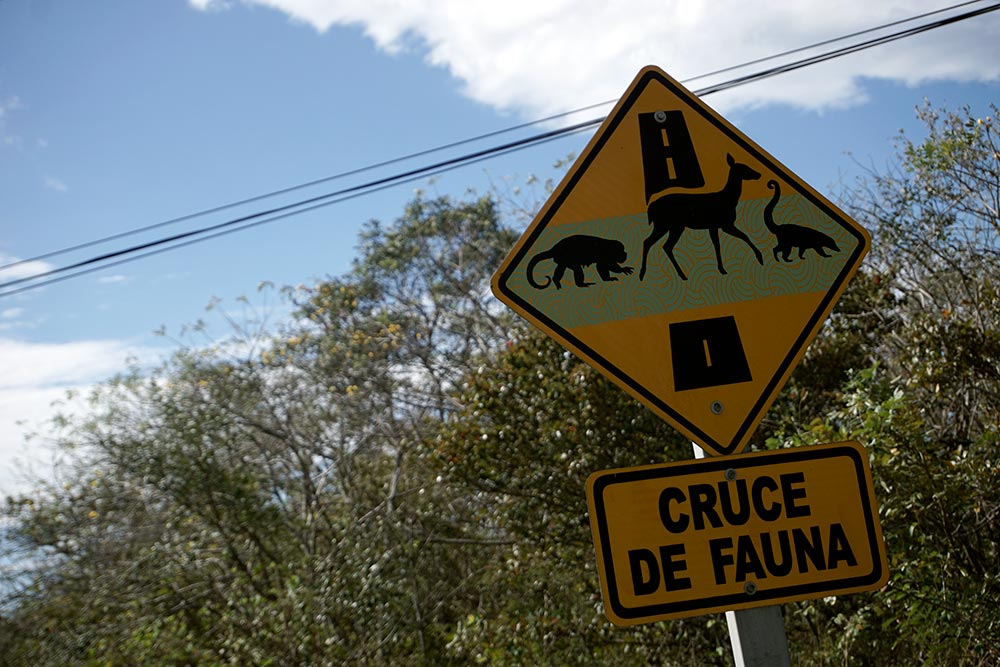
And snakes!
The 20 km that we rode to the beach went by extremely quickly given that it was almost all downhill. Our friends Mark and Hana had done all the groundwork when it came to locating a prime beach camping spot so all we had to do was follow our GPS to the waypoint that they had shared with us. Unfortunately, when we arrived, the secluded beach had a few other visitors there already. Expecting that they weren’t going to be staying much past dusk, we simply hung around for a while so as to not make our intention to camp there obvious. As we had assumed they would, once the sun had set, they departed, leaving Rebecca and I the entire beach to ourselves.
Our tent was pitched, dinner was prepared, and we enjoyed a campsite lit only by a thousand stars, our first wild camping spot in quite some time. Perhaps this would be a sign of good things to come? We hoped so.

Our camping spot. The land you see in the distance is completely submerged at high tide.
Given that we were unfamiliar with the area, before we set up camp we tried to determine just how large of a tide there was going to be. We were, after all, camping beside the Pacific Ocean. We set our tent above what we assumed was the high tide line and noted that the water continued to rise until approximately 7:00 PM, flooding the area that we had walked across to get there. Some very rough math led me to believe that high tide the following morning would be somewhat close to 7:00 AM so when we awoke, we hastened our departure to avoid having to get our feet wet. We made it just in time!

Making our getaway early before this beach floods.
Once beyond the area that would flood at high tide, we stopped again and boiled some water for a cup of coffee. After all, two days in a row without morning coffee is asking a bit too much. Properly caffeinated, we began the process of climbing a thousand feet back to the Pan Am Highway. The ride took place on quiet scenic paved roads bordered by colorful flowers and so even though it took some effort, it was not that bad. There’s nothing that gets a day started like a big climb though.
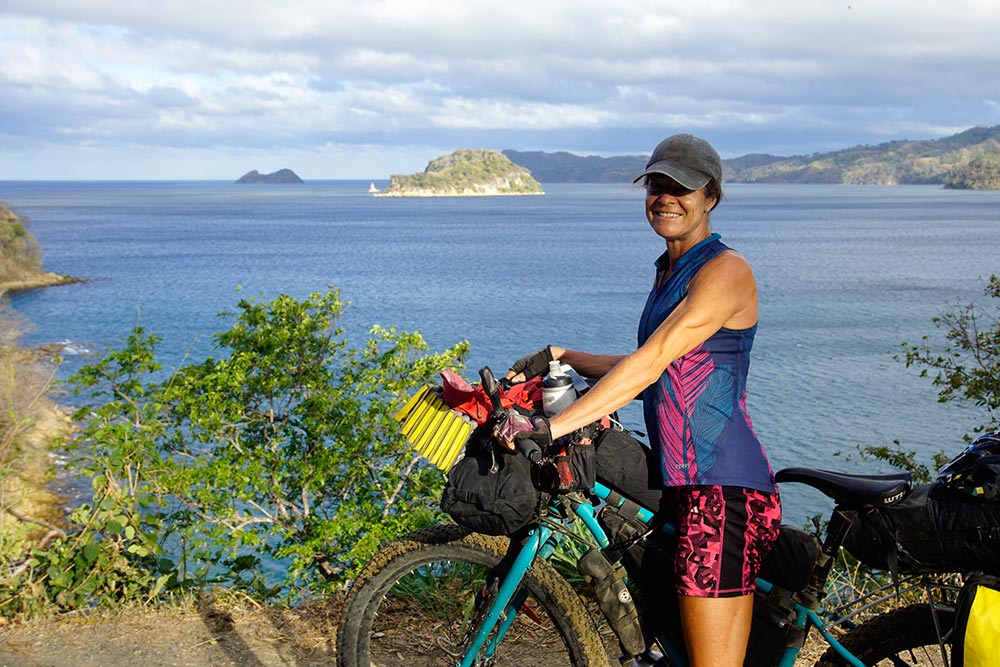
Beginning our climb back to the highway.

The pink on Rebecca’s shirt matches the color of those flowers.
When we left the Pan Am for the second time, we did so with only 30 kilometers or so to Liberia. The smart money would have just stayed on the highway but Rebecca and I, following in the tire tracks of Cass Gilbert and our friends Mark and Hana, made a 90-degree turn and started climbing towards the Rincón de la Vieja. Riding along the Pan Am we were surprised to see, or rather not see, a single eating establishment so, at that point, it was my stomach that was the driving force, and my sights were set on a town 7 km up the hill where I had hoped to find some food.

Quiet roads but very windy.

Should we just stay on the highway? Liberia is only 1.5 hours away.
Seven kilometers should go by pretty quickly, right? Wrong. Immediately after making that 90-degree turn to the east, we were hit with an incredible headwind and a wind farm that we could see in the distance made it obvious that this was no random occurrence. After all, they don’t build a hundred wind turbines where the breeze only blows occasionally!

Another wind farm!

Note that the wind turbine is almost perfectly aligned with the road.
I don’t want to sound overly dramatic but the wind was so strong that it brought us to a standstill on more than one occasion, and when it gusted to the side, it caused us to both swerve in unison or knocked us off the road. Driven by my empty stomach, I had only one thought on my mind: get to that village where I hoped there would be an eating establishment. Arriving there took far more time than it should have though. Ultimately, we made it, but with not an ounce of energy to spare.

Did all the leaves blow off this tree? Perhaps.

One of the best pizzas I have ever had. A true lifesaver.
As tired, hungry, and I’ll admit, frustrated as we were, there are not many things that could have totally revived us. We found one of them though… pizza. And not just any pizza. I’ll go out on a limb and say that the pizza we found there was one of the top 5 that I have ever had the pleasure to eat, and that’s not just my completely-empty stomach talking. No, it was that good. We ordered a large special-of-the-house for the two of us and over the course of 20 minutes or so, managed to polish off 3/4 of it. The remaining pieces we packed up to take with us. Yes, instead of turning around to enjoy a super-fast, downhill run back to the highway as most sane people would do, we were going to continue on to our destination, 26 km uphill and unwind.

Hiding under a bush. Yes, those are water droplets on the image.

This image was taken from our hiding spot under the bushes.
I’d like to say that we banged off that 26 km easily but that was not the case. The wind that we had experienced prior to our pizza stop continued and in fact, even accelerated as we climbed further up the mountain. And it rained. Hard. We were forced to take shelter a couple of times, the first under some bushes permanently-bowed from the wind and the second time, in a restaurant in the village of Neuvo Zelandia.
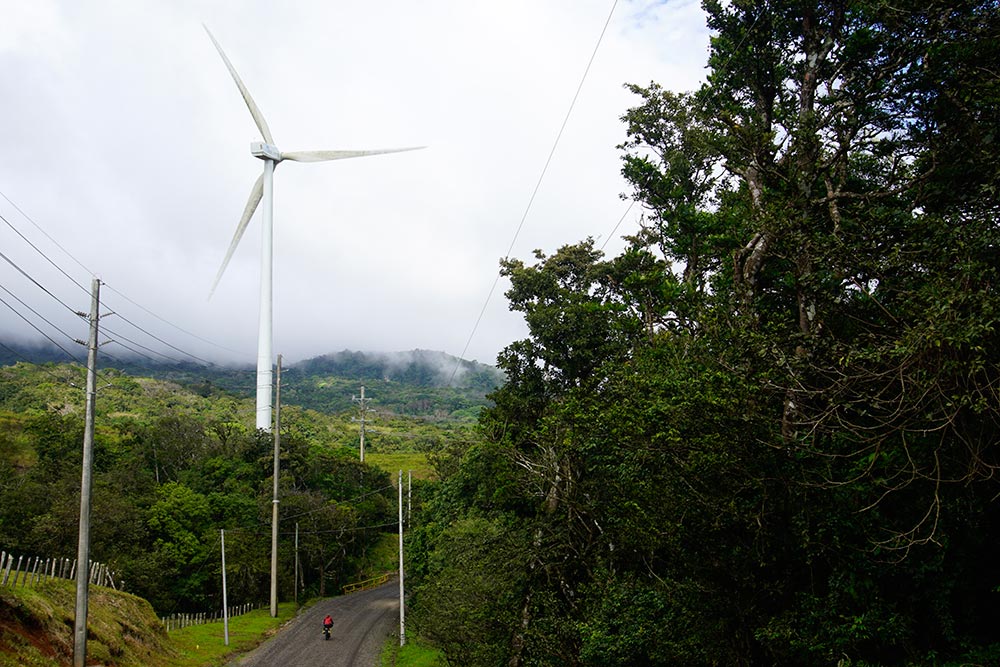
Massive!


We are often quite the spectacle for those traveling in tour buses.
Ultimately, we did make it to our planned stopping point, Buenos Aires, a small town in the shadow of the volcano. We had read that there was a good camping spot adjacent to a river just before the town but we made the same decision that our friends did and bypassed it, choosing instead to ride on into the town. When we asked the police officer in Buenos Aires if there was a safe place that we could camp, he directed us to pitch our tent on the community center lawn, right in front of his office. Fortunately, we experienced a break in the rain at that point, just long enough for us to set up camp and cook dinner. After that, it poured for much of the night.

Rincón de la Vieja in the distance.

Our community center camping spot across from the police station.
Before setting off the following morning, the kindly police officers heated us up some coffee and offered us a couple of pieces of sweet bread to go with it. While hiding from the drizzle in their office, I inquired about the two radio sets that were situated on the desk. I was told that one was for communicating with other police stations but that the second was to give volcano reports in the event of an eruption! At the time, we could see absolutely nothing of the volcano but I guess during the rare times when the sky clears — he told us that it always rains there — they have a pretty good view from that spot.

We got off lucky only having to do this once.

Climbing on very slick trails. We did this for hours.

Building a new bridge over the fast-flowing river.
Our ride from Buenos Aires took place on some very rough double track that was seriously slick from the rain. Having made another 90-degree turn, the headwind that we experienced the day before was less of an issue but the drizzle that we started the day with had, by then, turned into a full-on shower, causing us to struggle up the slippery trails. We crossed a number of rivers during this stretch but only one of them was absent of a bridge, a good thing because each was quite swollen due to the intense rainfall. When we ultimately made it to the pinnacle of the day’s climb, some 30 km from our starting point, we had had our fair share of exercise.

So lush and green.

The glamour of cycle touring.

A good spot out of the rain for a rest and a snack.
A twenty-eight-kilometer descent… that’s what followed the climbing that we had just completed. With one small exception, we coasted all the way to Liberia, and at times, quite quickly. That is not to say that it required no effort because, with the rough roads, we still had to post out of the saddle much of the time. So, even without peddling, our already tired legs got more of a workout. We weren’t complaining though as the fast descent was a rush. We had also, by that time, made our way out of the cloud forest so the sun shone down on us, warming our previously-chilled bodies.

The rain ultimately abated.

We took a little walk upstream to more closely inspect this waterfall.

Nearing the top of the day’s climb.
Arriving in Liberia, we began our typical find-a-place-to-stay routine. Keeping in mind what I had already written about Costa Rica’s higher prices, the process went basically like this:
- Hotel 1. $50.00 Haha. Kept on going.
- Hotel 2. $28.00. Tiny room way in the back of a hostel. Kept on going.
- Hotel 3. $34.00. Tiny and nothing special. Kept on going.
- Hotel 4. “You must have a reservation.” Well, OK then. Kept on going.
- Hotel 5. No rooms available. Kept on going.
- Hotel 6. $17.00. Super friendly owner. Fridge. Ice. Microwave. Good WiFi. Room big enough for our bikes. WINNER! For the record, the winner was Hospedaje Condega. Tel: 2666-1165

The one exception to our 28 km descent to Liberia.

The rest of the descent was very fast!
Our patience and persistence had paid off. So much so that we decided to spend a couple of extra days in Liberia to rest our bodies, send our bikes to the spa (bike shop for a tune-up), and to make plans for our future travels through Costa Rica and beyond. More big adventures await!
NOTE: More than one person told us that it’s only this windy here during the winter months, similar to the Christmas Winds that we experienced in the Eastern Caribbean. We were told that come April there will be no wind here at all.


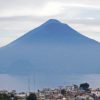

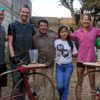
also called “gap” winds or in Costa Rica referred to as the “Papagayos”
Cool.
https://en.wikipedia.org/wiki/Papagayo_Jet
You guys should pamper yourselves a little and check this out while you’re in costa rica: https://envisionfestival.com/
Not so sure that would be our cup of tea. 🙂
You mentioned that the wind turbines where noisy, I was wonderdering the same as I was reading your post. Do they make a humming sound? Have you encountered any exotic animals on your bike tour? I have been following you and Rebecca for a long time. Im from Dallas, Texas.
I thought that they sounded a lot like a jet aircraft, or a massive helicopter.
As for exotic animals, we just saw an armadillo for the first time. That’s not so exotic, I guess. We’ve seen a few boas but they had all had unfortunate run-ins with automobiles. We’ve seen some monkeys, green macaws, and a couple of coatis. They’re fairly exotic.